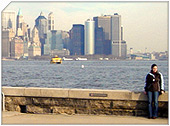Getting Started
Index
NYC Neighborhoods
Manhattan
Brooklyn
Queens
Bronx
Staten Island
NYC Icons
Chrysler Building
Flatiron Building
Empire State Building
Safe NYC
NYPD
FDNY
NYC Weather
NYC Climate
NYC Weather Forecast
Winter Season
Spring Season
Summer Season
Fall Season
NYC History & Politics
New York City History
Tammany Hall and Politics
New York City Politicians
New York City Personalities
Culture of Gotham City
Culture of the city
Cultural diversity
City in popular culture
|
Long Island Sound is an estuary of the Atlantic Ocean and various rivers in the United States. It lies between the coast of Connecticut to the north and Long Island, New York to the south. The mouth of the Connecticut River at Old Saybrook, Connecticut empties into the sound. On the extreme western end, the sound is bounded on the north side by Westchester County, New York and the Bronx, and connects to the East River. On its eastern end it opens to Block Island Sound. The sound is considered by some to be the natural border between New England and the Mid-Atlantic states.
Several major cities are situated along the Long Island Sound, resulting in a total of more than 8 million people living within its watershed. Major Connecticut cities on the Sound include Bridgeport, New London, Stamford, Norwalk, and New Haven. New York cities on the Sound include Port Jefferson and New York City (the boroughs of Queens and the Bronx).
Mansions and wealthy neighborhoods characterize a good portion of the coast of the sound from Whitestone, Queens out to Setauket and Port Jefferson on Long Island; and from Greenwich to beyond Madison in Connecticut. Property values in Connecticut and Long Island are among the highest in the nation, mostly due to the proximity to New York City and "the sound." Southwestern Connecticut and the North Shore of Long Island are rivals for the title of "Gold Coast" because of the affluent communities situated along the shore.
Glacial history
About 18,000 years ago, Connecticut, the Sound and much of Long Island were covered by a thick sheet of ice, part of the Late Wisconsin Glacier. About 1,000 meters thick in its interior and about 400 to 500 meters thick along its southern edge, it was the most recent of a series of glaciations covering the area over the past 10 million years. Sea level at that time was about 100 meters lower than today.
The glacier scraped off an average of 20 meters of surface material from the New England landscape, then deposited the sediments, known as drift or terminal moraine, on Long Island, in the Sound and on the Connecticut coast. When the glacier stopped growing for a while 18,000 years ago (as movement of the glacier was in equilibrium with the melting at the southern edge), a large amount of drift was deposited, known as the Ronkonkoma Moraine, which stretches along much of southern Long Island. Later, another period of equilibrium resulted in the Harbor Hill Moraine along most of northern Long Island. The next moraines to the north were created just on and off the Connecticut coast. These moraines, created by much smaller deposits (probably from equilibrium states that were much shorter in time) are discontinuous and much smaller than those to the south. The Connecticut coast moraines are in two groups: the Norwalk area and the Madison-Old Saybrook area. Sandy plains and beaches resulted from the deposit of drift in these areas, and to the east of each, where the drift cover is thinnest, exposed bedrock creates rocky headlands, often with marshlands behind them.
The Captain Islands off of Greenwich, Connecticut, along with the Norwalk Islands and Falkner Island off Guilford, Connecticut are parts of a terminal moraine. (Other islands, including the Thimble Islands, are for the most part exposed bedrock with a thin amount of drift, often not continuous. Other shoals and islands off the Connecticut coast are a mixture of these two extremes. The glacier also created several sandy outwash deltas off the coast, including one off of Bridgeport, Connecticut and another off of New Haven, Connecticut. Fishers Island, New York appears to be related to the Harbor Hill Moraine. To the east of the Thimble Islands, inland moraines along the Connecticut coast include the broken Madison Moraine and the Old Saybrook Moraine.
The Long Island Sound basin existed before the glaciers came. It probably had been formed by stream flows. A relatively thick cover of sand and gravel (termed outwash) was left in the basin from glacial meltwater streams. On the west, a ridge rising to about 20 meters below the present sea level is called the Mattatuck Sill. Its lowest point is about 25 meters below sea level. Glacial meltwater formed "Lake Connecticut", a freshwater lake in the basin, until about 8,000 years ago, when the sea level rose to about 25 meters below today's level. Seawater then overflowed into the basin, transforming it from a nontidal, freshwater lake to a tidal, saline arm of the sea.
|
New York City Search
Quick NYC
|



 New York Weather Forecast
New York Weather Forecast
 Ethnic composition
Ethnic composition


















